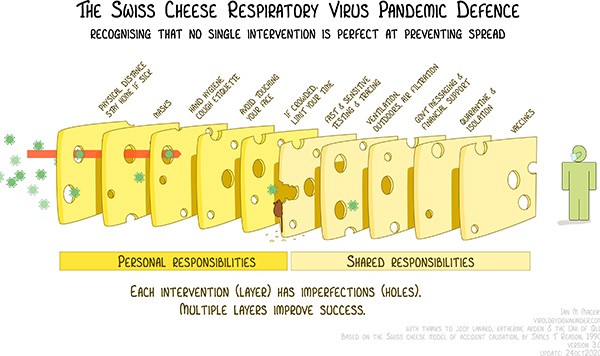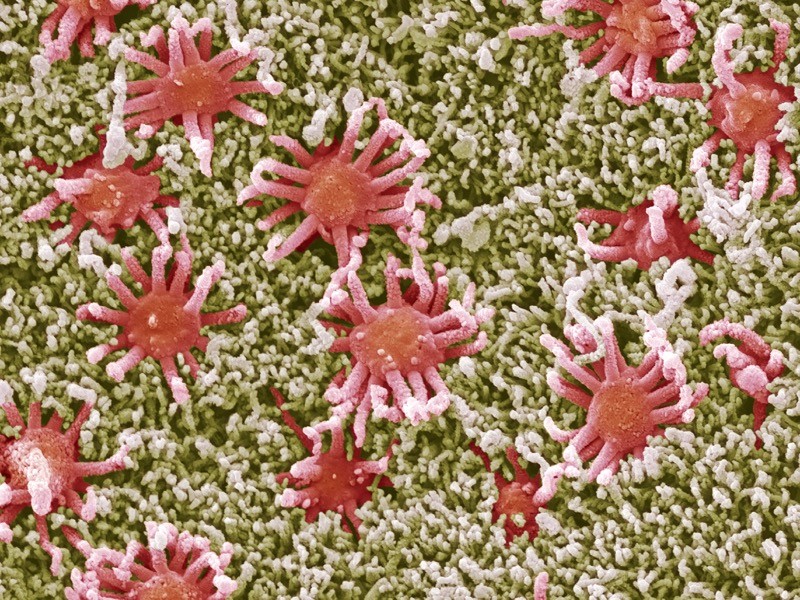By Siobhan Roberts
- Published Dec. 5, 2020Updated Dec. 7, 2020, 3:24 p.m. ET
Lately, in the ongoing conversation about how to defeat the coronavirus, experts have made reference to the “Swiss cheese model” of pandemic defense.
The metaphor is easy enough to grasp: Multiple layers of protection, imagined as cheese slices, block the spread of the new coronavirus, SARS-CoV-2, the virus that causes Covid-19. No one layer is perfect; each has holes, and when the holes align, the risk of infection increases. But several layers combined — social distancing, plus masks, plus hand-washing, plus testing and tracing, plus ventilation, plus government messaging — significantly reduce the overall risk. Vaccination will add one more protective layer.
“Pretty soon you’ve created an impenetrable barrier, and you really can quench the transmission of the virus,” said Dr. Julie Gerberding, executive vice president and chief patient officer at Merck, who recently referenced the Swiss cheese model when speaking at a virtual gala fund-raiser for MoMath, the National Museum of Mathematics in Manhattan.
“But it requires all of those things, not just one of those things,” she added. “I think that’s what our population is having trouble getting their head around. We want to believe that there is going to come this magic day when suddenly 300 million doses of vaccine will be available and we can go back to work and things will return to normal. That is absolutely not going to happen fast.”
“One of the first principles of pandemic response is, or ought to be, clear and consistent messaging from trusted sources,” Dr. Hanage said in an email. “Unfortunately the independence of established authorities like the C.D.C. has been called into question, and trust needs to be rebuilt as a matter of urgency.” A catchy infographic is a powerful message, he said, but ultimately requires higher-level support.
The Swiss cheese concept originated with James T. Reason, a cognitive psychologist, now a professor emeritus at the University of Manchester, England, in his 1990 book, “
Human Error.” A succession of disasters — including the Challenger shuttle explosion, Bhopal and Chernobyl — motivated the concept, and it became known as the “Swiss cheese model of accidents,” with the holes in the cheese slices representing
errors that accumulate and lead to adverse events.
The model has been widely used by safety analysts in various industries, including medicine and aviation, for many years. (Dr. Reason did not devise the “Swiss cheese” label; that is attributed to Rob Lee, an Australian air-safety expert, in the 1990s.) The model became famous, but it was not accepted uncritically; Dr. Reason himself noted that it had limitations and was intended as a generic tool or guide. In 2004, at a workshop addressing an aviation accident two years earlier near Überlingen, Germany, he delivered a talk with the title, “Überlingen: Is Swiss cheese past its sell-by date?”
The cheese metaphor now pairs fairly well with the coronavirus pandemic. Ian M. Mackay, a virologist at the University of Queensland, in Brisbane, Australia, saw a smaller version on Twitter, but thought that it could do with more slices, more information. He created, with collaborators, the “
Swiss Cheese Respiratory Pandemic Defense” and engaged his Twitter community, asking for feedback and putting the visualization through many iterations. “Community engagement is very high!” he said. Now circulating widely, the infographic has been
translated into more than two dozen languages.
To test a coronavirus vaccine, for instance, researchers compare how many people in the vaccinated and placebo groups get Covid-19. Effectiveness, by contrast, is the benefit that a vaccine or a drug provides out in the real world. A vaccine's effectiveness may turn out to be lower or higher than its efficacy.
- Phase 1, 2, and 3 trials: Clinical trials typically take place in three stages. Phase 1 trials usually involve a few dozen people and are designed to observe whether a vaccine or drug is safe. Phase 2 trials, involving hundreds of people, allow researchers to try out different doses and gather more measurements about the vaccine’s effects on the immune system. Phase 3 trials, involving thousands or tens of thousands of volunteers, determine the safety and efficacy of the vaccine or drug by waiting to see how many people are protected from the disease it’s designed to fight.
- Placebo: A substance that has no therapeutic effect, often used in a clinical trial. To see if a vaccine can prevent Covid-19, for example, researchers may inject the vaccine into half of their volunteers, while the other half get a placebo of salt water. They can then compare how many people in each group get infected.
- Post-market surveillance: The monitoring that takes place after a vaccine or drug has been approved and is regularly prescribed by doctors. This surveillance typically confirms that the treatment is safe. On rare occasions, it detects side effects in certain groups of people that were missed during clinical trials.
- Preclinical research: Studies that take place before the start of a clinical trial, typically involving experiments where a treatment is tested on cells or in animals.
- Viral vector vaccines: A type of vaccine that uses a harmless virus to chauffeur immune-system-stimulating ingredients into the human body. Viral vectors are used in several experimental Covid-19 vaccines, including those developed by AstraZeneca and Johnson & Johnson. Both of these companies are using a common cold virus called an adenovirus as their vector. The adenovirus carries coronavirus genes.
- Trial protocol: A series of procedures to be carried out during a clinical trial.
We don’t talk about eye coverings much, but we should, because we don’t know enough about the role of eyes in transmission. We do know that eyes are a window to the upper respiratory tract.
Q. Where does the “misinformation mouse” fit in?
A. The misinformation mouse can erode any of those layers. People who are uncertain about an intervention may be swayed by a loud and confident-sounding voice proclaiming that a particular layer is ineffective. Usually, that voice is not an expert on the subject at all. When you look to the experts — usually to your local public health authorities or the World Health Organization — you’ll find reliable information.
An effect doesn’t have to be perfect to reduce your risk and the risk to those around you. We need to remember that we’re all part of a society, and if we each do our part, we can keep each other safer, which pays off for us as well.
Another example: We look both ways for oncoming traffic before crossing a road. This reduces our risk of being hit by a car but doesn’t reduce it to zero. A speeding car could still come out of nowhere. But if we also cross with the lights, and keep looking as we walk, and don’t stare at our phone, we drastically reduce our risk of being hit. We’re already used to doing that. When we listen to the loud nonexperts who have no experience in protecting our health and safety, we are inviting them to have an impact in our lives. That’s not a risk we should take. We just need to get used to these new risk-reduction steps for today’s new risk — a respiratory virus pandemic, instead of a car.
Q. What is our individual responsibility?
A. We each need to do our part: stay apart from others, wear a mask when we can’t, think about our surroundings, for example. But we can also expect our leadership to be working to create the circumstances for us to be safe — like regulations about the air exchange inside public spaces, creating quarantine and isolation premises, communicating specifically with us (not just at us), limiting border travel, pushing us to keep getting our health checks, and providing mental health or financial support for those who suffer or can’t get paid while in a lockdown.
Q. How can we make the model stick?
A. We each use these approaches in everyday life. But for the pandemic, this all feels new and like a lot of extra work. Because everything is new. In the end, though, we’re just forming new habits. Like navigating our latest phone’s operating system or learning how to play that new console game I got for my birthday. It might take some time to get across it all, but it’s worthwhile. In working together to reduce the risk of infection, we can save lives and improve health.
And as a bonus, the multilayered risk reduction approach can even decrease the number of times we get the flu or a bad chest cold. Also, sometimes slices sit under a mandate — it’s important we also abide by those rules and do what the experts think we should. They’re looking out for our health.



